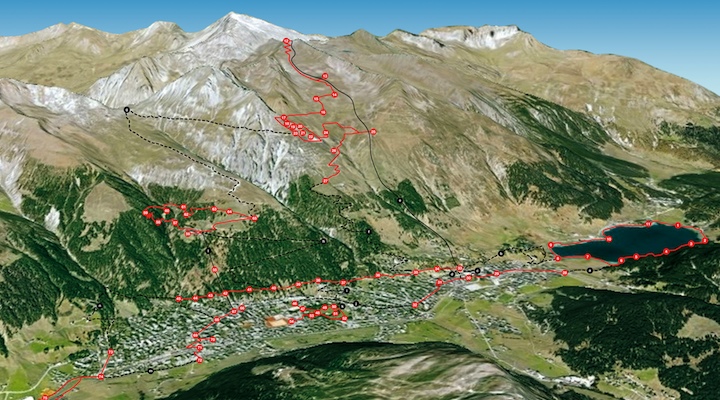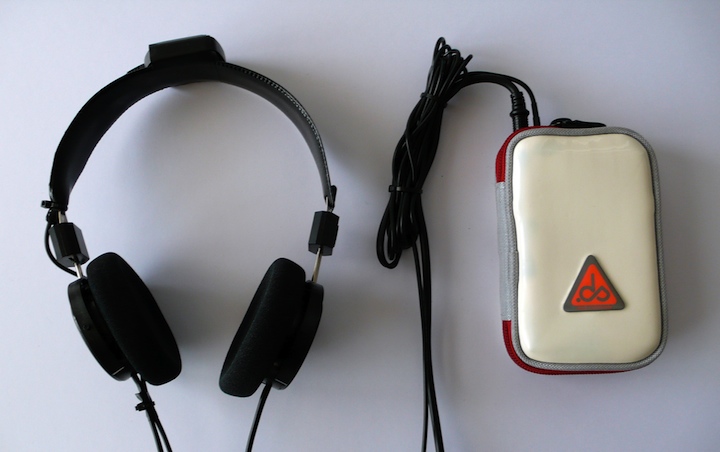
Davos Soundscape
A topographical composition by Jan Schacher and Marcus Maeder for the Davos Festival 2007, Switzerland.

The experience and composition of .ds – davos soundscape emerges from the movement, peregrination and strolling of the listeners throughout the landscape of Davos and surroundings. Ten microcomputers equipped with GPS were available at the Davos Tourist Office.
Together with the device the visitor received a map (see image on top) with the proposed routes and a diagram showing the locations of sound fragments. These sound-zones or so-called “sweet spots” were placed in the landscape with a surveyor’s stake painted in a fluorescent color to mark the area where a piece of music or sound is located and to simplify the acoustic “treasure hunt”.
Together with the device the visitor received a map (see image on top) with the proposed routes and a diagram showing the locations of sound fragments. These sound-zones or so-called “sweet spots” were placed in the landscape with a surveyor’s stake painted in a fluorescent color to mark the area where a piece of music or sound is located and to simplify the acoustic “treasure hunt”.
Read a more in-depth description of this project in an article published in the proceedings of the 2008 Conference for New Instruments for Musical Expression NIME here
Project Gallery
The .ds GPS audio device

The Open Work – Ritornello – Soundscapes and Sweet Spots
marcus maeder
.ds davos soundscape is based upon two concepts. The first – The Open Work – stems from Umberto Eco and is the title of one of the most influential papers about contemporary aesthetics. The text, which dates to the year 1962, defines an open work as one that doesn’t intent to convey a definite meaning to be comprehended by the audience. The creation of the work of art is much rather an act into which the perceiving individual is directly involved by assigning the work a personal meaning. In .ds davos soundscape we intend to intensify this relationship insofar as we establish a composition in the landscape whose temporal structure and sonic attributes are generated by the presence and movement of the public in a real territory.
In their seminal book “A Thousand Plateaus” the two authors – philosopher Gilles Deleuze and psychiatrist Félix Guattari – have addressed the territoriality of sound and music in an extremely inspiring way. Their approach to the concept of the ritornello is quite unique. The term ritornello is known from baroque music: it denotes the part of a rondo that returns periodically, like a refrain during the course of the piece. Deleuze und Guattari consider the ritornello in an extended sense as the sound(track) or melody or acoustic signature that defines a natural territory. Humans and animals produce this kind of ritornello. A child that sings a song in the dark does this to block out its fear, to create through song a stabilizing centre in the “chaos” of the unknown and to establish a safe territory. Birds establish through their repeated song pattern their territory and thus build an acoustic barrier around it. The ritornello is territorial or localized and according to Deleuze and Guattari even the keys and rhythms in music are territorial and influenced by their regional provenance.
Sounds form territorial structures and from this fact originates the term ‘soundscape’: a sonic landscape. A sonic landscape consists of acoustic environments that can be traversed. They overlap, are defined and shift in relationship to each other. Sonic environments can be entered, traversed and left: this constitutes the territories – according to Deleuze and Guattari the defining of a territory is the act, the action which influences sounds and environments and territorializes them by using their specific characteristics. When the sonic and acoustic factors and components of an environment cease being functional and acquire an expressive quality they generate a territory. In .ds davos soundscape we shape the sonic environments by marking them acoustically and giving geographical elements a musical shape.
We plant a number of sound zones or acoustic markings in Davos’ landscape. Sound engineers call the area within a loudspeaker setup, which gives the best listening result the “sweet spot”. By taking this concept into the landscape our “sweet spots” become the centers of topographical, acoustic and musical circles. We define and compose the sonic territory specifically in relationship to the characteristics present in such a zone. The starting points and basic materials for the sound of an area are located on these spots. Fascinated by the specific natural sound ambience of a place, for instance the murmuring of a brook or the geographical properties of a stretch of forest we might be inspired to compose a romantic motif of melody-loop.
.ds davos soundscape creates a composition and sonic landscape from a number of sound territories and overlapping sonic circles. By moving through the zones and areas the visitors create their own open composition. The routes proposed on the .ds map can be followed in any direction and may be experienced in shorter sections. The totality of the zones emphasizes the eclectic and sometimes contradictory character of Davos’s landscape: Davos Dorf and Platz present an urban face, the zones of Schatzalp and Weissfluhjoch show their alpine character, whereas the path around the lake and along the Landwasser river to the woods cemetery are idyllic and on a stroll in the Kurpark and along the high promenade a more cultivated experience ensues. By following the routes and zones in an personal manner, varying chronologies and superpositions of our sounds emerge and a non-linear soundtrack to a movement through the landscape is produced.
.ds davos soundscape is based upon two concepts. The first – The Open Work – stems from Umberto Eco and is the title of one of the most influential papers about contemporary aesthetics. The text, which dates to the year 1962, defines an open work as one that doesn’t intent to convey a definite meaning to be comprehended by the audience. The creation of the work of art is much rather an act into which the perceiving individual is directly involved by assigning the work a personal meaning. In .ds davos soundscape we intend to intensify this relationship insofar as we establish a composition in the landscape whose temporal structure and sonic attributes are generated by the presence and movement of the public in a real territory.
In their seminal book “A Thousand Plateaus” the two authors – philosopher Gilles Deleuze and psychiatrist Félix Guattari – have addressed the territoriality of sound and music in an extremely inspiring way. Their approach to the concept of the ritornello is quite unique. The term ritornello is known from baroque music: it denotes the part of a rondo that returns periodically, like a refrain during the course of the piece. Deleuze und Guattari consider the ritornello in an extended sense as the sound(track) or melody or acoustic signature that defines a natural territory. Humans and animals produce this kind of ritornello. A child that sings a song in the dark does this to block out its fear, to create through song a stabilizing centre in the “chaos” of the unknown and to establish a safe territory. Birds establish through their repeated song pattern their territory and thus build an acoustic barrier around it. The ritornello is territorial or localized and according to Deleuze and Guattari even the keys and rhythms in music are territorial and influenced by their regional provenance.
Sounds form territorial structures and from this fact originates the term ‘soundscape’: a sonic landscape. A sonic landscape consists of acoustic environments that can be traversed. They overlap, are defined and shift in relationship to each other. Sonic environments can be entered, traversed and left: this constitutes the territories – according to Deleuze and Guattari the defining of a territory is the act, the action which influences sounds and environments and territorializes them by using their specific characteristics. When the sonic and acoustic factors and components of an environment cease being functional and acquire an expressive quality they generate a territory. In .ds davos soundscape we shape the sonic environments by marking them acoustically and giving geographical elements a musical shape.
We plant a number of sound zones or acoustic markings in Davos’ landscape. Sound engineers call the area within a loudspeaker setup, which gives the best listening result the “sweet spot”. By taking this concept into the landscape our “sweet spots” become the centers of topographical, acoustic and musical circles. We define and compose the sonic territory specifically in relationship to the characteristics present in such a zone. The starting points and basic materials for the sound of an area are located on these spots. Fascinated by the specific natural sound ambience of a place, for instance the murmuring of a brook or the geographical properties of a stretch of forest we might be inspired to compose a romantic motif of melody-loop.
.ds davos soundscape creates a composition and sonic landscape from a number of sound territories and overlapping sonic circles. By moving through the zones and areas the visitors create their own open composition. The routes proposed on the .ds map can be followed in any direction and may be experienced in shorter sections. The totality of the zones emphasizes the eclectic and sometimes contradictory character of Davos’s landscape: Davos Dorf and Platz present an urban face, the zones of Schatzalp and Weissfluhjoch show their alpine character, whereas the path around the lake and along the Landwasser river to the woods cemetery are idyllic and on a stroll in the Kurpark and along the high promenade a more cultivated experience ensues. By following the routes and zones in an personal manner, varying chronologies and superpositions of our sounds emerge and a non-linear soundtrack to a movement through the landscape is produced.
























